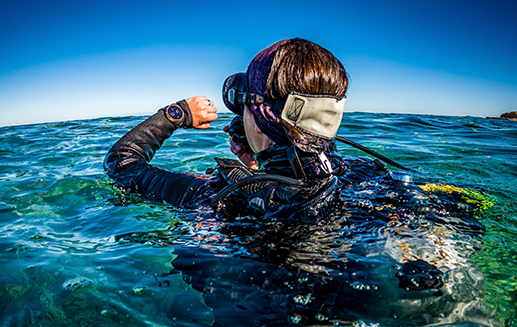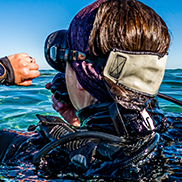THEY SURFACED AND THE DIVE BOAT WAS NOWHERE TO BE SEEN
The public broadcaster in the UK (the BBC) recently aired an interview with a couple of divers who spent 36 hours drifting off the Texas coast before being rescued by the US coast guard.

Nathan and Kim Maker became separated from the charter boat in what was reported as bad weather and heavy seas. According to a fellow diver, the pair disappeared when “a huge swell comes in and engulfs Kim and Nathan totally. When the swell rolls out, they’re nowhere to be found.” And although the folks on the boat began to search for the pair immediately, they were gone.
Few of us can imagine what it took for the Makers to hang on to their sanity and keep their spirits up while they drifted around, lost and alone. And the BBC story was a brilliant illustration of… well, the right words have to be gumption and faith.
But, all that aside, is there something to be learned from their adventure… apart from never give up?
As a dive agency, the answer to that simple question is, yes. We can learn something.
It’s part of our job to modify what we suggest and advise students to do whenever an actual dive story presents us with an opportunity to share and learn. And this incident presents just that sort of opportunity.
RAID offers a boat diving specialty. Perhaps this story points out that it’s time for an update. It’s time for our editorial team to put RAID Boat Diver on the list of course materials to be reviewed. It’s not that divers get washed away from their buddies on a regular basis, but it happens. Occasionally, too, a boat will leave a dive site when divers are still submerged. We can never make it certain that neither of these things happen again, but we can recommend some revised ‘contingency plans’!
There isn’t space or time — and this isn’t the place — to deliver a whole diver manual for any RAID program, including Boat Diver. But here are some suggestions for any of you with plans to dive off-shore where tides, current, lumpy seas, or a tonne of other things might turn your day on its head.
First is always carry a SMB (surface marker buoy) or a safety sausage. When diving current, a minimum of three (including a DSMB) per buddy team. is recommended. (Two for each diver is even better.) Also, carry a spool or small diver’s reel (a cavern reel is a good choice), and load it with #36 or #48 kernmantle. (Line a little stronger than the #24 line that cave divers use.) In fact, carry two. Make sure as well, that both you and your buddy have a “surface signalling device.” This could be as simple as a Fox whistle or a scuba diver’s air horn. Many recommend a signalling mirror as well. A signalling mirror is as useful as a chocolate teapot when it’s cloudy or at night. A better choice is a modern diver’s backup light (small and powerful). An alternative is a wreck-diver’s strobe light. But, in either case, do make sure the batteries are charged!
There is a RAID instructor who always sits a very large, very colourful safety sausage in his place on dive boats before he jumps in the water. He explains this habit by saying: “that way, they can’t forget me.” He’s strategy seems to work and makes him a difficult passenger to miss. He has never been left behind! He is much too much of a presence for that. But for the more introverted among us, there are easier ways to track and log divers. And at very least, make sure that during post-dive roll call, your absence would be apparent.
And finally, if your diving takes you well away from shore or you dive in strong currents, or your dive profiles are deep and long, we recommend packing a scuba diver’s GPS or rescue beacon in a pocket or pouch. There are several models on the market, so do a little research. They are not cheap, but they’re a bargain if they can save you and your buddy a night bobbing around in the ocean.


